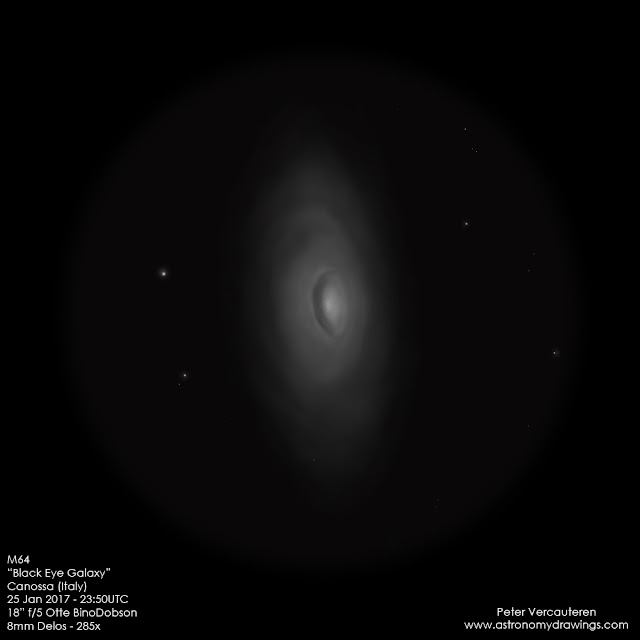I've never been very fond of galaxies. Yes, there are some really nice ones such as M51, the famous Whirlpool, or M82, the Cigar Galaxy, without even mentioning Andromeda. But in the end, most galaxies appeared to me as amorphous, faint blobs lacking the details that could make them interesting. Perhaps I should've looked a little better, but in general I loved nebulae a thousand times more. At least these always showed me some remarkable details, frail filaments or internal structures.
In comes the 18" binoscope and now things have changed. As you can see on my sketches, even very faint and distant galaxies have taken form and character. Sometimes, galaxies now reveal the scars of such cataclisms as we with our small human minds couldn't possibly imagine. I've talked about galaxies being torn apart by another galaxy zooming by such as the Tadpole or the galactic tango of NGC627 and IC1727 (see the video here). I've also already talked about galaxies crashing into other galaxies, such as the Flying Ghost. But in the end, the universe continues to be and even the scariest of scars will heal with time. The Tadpole's long trail of stars and matter will break off and probably form a new mini-galaxy of its own. The two wild tangoers will eventually regroup their stars and in a few billion years no-one will still be able to recognise a flying ghost in the seemingly normal, albeit enlarged NGC520.
And yet, that's not entirely true. Sometimes these scars will not heal completely. Take a small telescope and point it at M64, one of the finest galaxies in spring sky. You will notice that there's a dark patch under the bright nucleus, hence the nickname "Black Eye Galaxy". The larger the telescope, the more prominent this dark patch becomes and with my binoscope I saw it like on the sketch below. It even gave a sort of 3D-sensation to the galaxy's central part as if I was looking at a lunar crater! These enormous dark clouds of dust around the nucleus are caused by a strange phenomenon: the outer 40.000 lightyears of this galaxy are rotating in the opposite direction of the inner 3.000! The friction that this counterrotation causes at the separation point is generating thick clouds of swirling matter and... violent star formation! Now you might wonder... what the heck caused the outer part of a galaxy to counterrotate the inner part? The most likely explanation seems to be that billions of years ago another galaxy collided with it in the opposite direction of its rotation and was eventually absorbed. Perhaps one day the rotation of the large outer region will slow down, come to a halt and will then obey the galaxy's gravitational centre which tells it to rotate in the same direction as the nucleus. But for the time being it's still going its own way and the black eye's the proof that this galaxy's received a pretty hard blow to the head.







